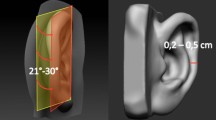Abstract
Background
The prominence of the ear lobule is considered an anomaly of secondary importance and receives correspondingly less attention in literature. We reviewed a case series of otoplasty patients and analyzed the prevalence of lobule prominence.
Methods
Records of otoplasties between 2007 and 2013 were reviewed. Inclusion criteria were: (1) primary otoplasties; (2) prominence of both ears; and (3) otoplasties conducted by the main author. Patients were divided into two groups: (1) A general group (GG) containing all the patients, and (2) a lobule correction group (LG)—a subgroup of GG containing only the patients who needed lobule correction.
Results
From a total of 291 patients, 120 patients were included in GG and 27 patients in LG. There was no statistical difference between groups GG and LG in terms of age and gender. Preoperative diagnosis of lobule prominence was correctly established in 14 patients; 13 patients were diagnosed during surgery.
Conclusions
Lobule prominence should not be underestimated since its diagnosis may be missed in the preoperative period—nearly 50 % in our case. Also its prevalence (22.5 %) is not as infrequent as some may think. Knowledge of lobule correction techniques before surgery is important to avoid less than optimal results in otoplasty.
Level of Evidence V
This journal requires that authors assign a level of evidence to each article. For a full description of these Evidence-Based Medicine ratings, please refer to the Table of Contents or the online Instructions to Authors www.springer.com/00266










Similar content being viewed by others
References
Kelley P, Hollier L, Stal S (2003) Otoplasty: evaluation, technique, and review. J Craniofac Surg 14:643e–653e
Hunter AGW, Yotsuyanagi T (2005) The external ear: more attention to detail may aid syndrome diagnosis and contribute answers to embryological questions. Am J Med Genet 135A:237–250
Janis JE, Rohrich RJ, Gutowski KA (2005) Otoplasty. Plast Reconstr Surg 115:60e–72e
Limandjaja GC, Breugem CC, Molen ABM, Kon M (2009) Complications of otoplasty: a literature review. J Plast Reconstr Aesthet Surg 62:19–27
Caouette-Laberge L, Guay N, Bortoluzzi P, Belleville C (2000) Otoplasty: anterior scoring technique and results in 500 cases. Plast Reconstr Surg 105:504–515
Siegert R (2004) Correction of the lobule. Facial Plast Surg 20:293–298
Gosain AK, Resinos RF (2003) A novel approach to correction of the prominent lobule during otoplasty. Plast Reconstr Surg 112:575–583
McDowell AJ (1968) Goals in otoplasty for protruding ears. Plast Reconstr Surg 41:17–27
Furnas DW (2002) Otoplasty for prominent ears. Clin Plastic Surg 29:273–288
Mustardé JC (1967) The treatment of prominent ears by buried mattress sutures: a ten year survey. Plast Reconstr Surg 39:382–386
Furnas DW (1968) Correction of prominent ears by concha-mastoid sutures. Plast Reconstr Surg 42:189–193
Converse JM, Wood-Smith D (1963) Technical details in the surgical correction of the lop ear deformity. Plast Reconstr Surg 31:118–128
Webster GV (1969) The tail of the helix as a key to otoplasty. Plast Reconstr Surg 44:455–460
Nuara MJ, Mobley SR (2006) Nuances of otoplasty: a comprehensive review of the past 20 years. Facial Plast Surg Clin N Am 14:89–102
Georgiade GS, Riefkohl R, Georgiade NG (1995) Prominent ears and their correction: a forty-year experience. Aesthetic Plast Surg 19:439–443
Furnas DW (2002) Otoplasty for prominent ears. Clin Plast Surg 29:273–288
Spira M, McCrea R, Gerow FJ, Hardy FB (1969) Correction of the principal deformities causing protruding ears. Plast Reconstr Surg 44:150–154
Sadove M, Eppley BL (1997) Lobule repositioning in aesthetic otoplasty. Op Techn Plast Reconstr Surg 4:129–133
Author information
Authors and Affiliations
Corresponding author
Ethics declarations
Conflict of Interest
The authors declare that they have no conflicts of interest to disclose.
Rights and permissions
About this article
Cite this article
Ungarelli, L.F., de Andrade, C.Z.N., Marques, E.G.S.C. et al. Diagnosis and Prevalence of Prominent Lobules in Otoplasty: Analysis of 120 Patients with Prominent Ears. Aesth Plast Surg 40, 645–651 (2016). https://doi.org/10.1007/s00266-016-0678-x
Received:
Accepted:
Published:
Issue Date:
DOI: https://doi.org/10.1007/s00266-016-0678-x




